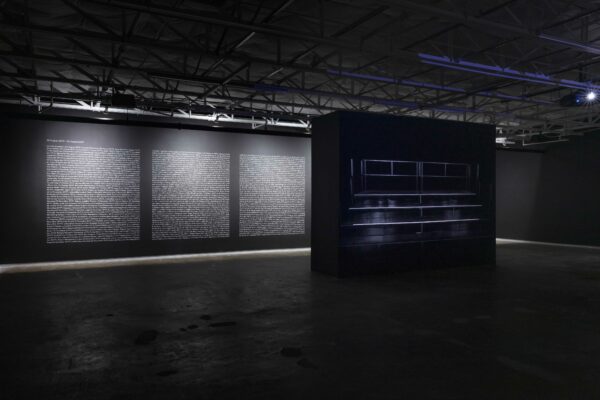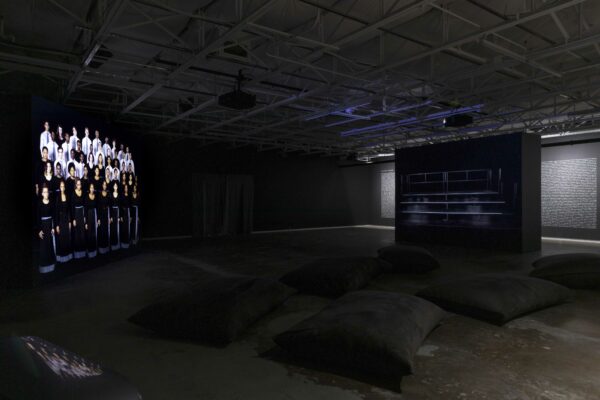South African artist Gabrielle Goliath’s powerful, aural/video installation at the Dallas Contemporary raises awareness about the insidious rape and femicide culture embedded within the country’s patriarchal society. The work features a large projection of the University of Cape Town’s choir, which performs a sonic eulogy in honor of 19-year old university student Uyinene Mrwetyana, who was brutally raped and murdered in 2019.
Singing is a universal form of honoring those who have passed. What makes this performance so unusual and riveting, however, is the absence of song. The 46 choir members collectively hum for 23 minutes. On an opposing screen is another video projection — this one featuring empty bleachers. The absence of human presence in the video signifies the many women, children and LGBTQIA+ individuals who have been murdered in South Africa. On the far wall of the gallery is a list of 680 names of those who have been murdered in South Africa since Mrwetyana’s death.
My first visit to the gallery, I brought my UT Dallas art students. As we entered the darkened space, some students sat on the floor, some stood watching the video, and some walked throughout the space, reading each name on the wall. We stayed for the entire 23 minutes, watching as the choir exited the bleachers. Then we exited the space, sitting outside the gallery in a circle, observing five minutes of silence. We then spoke about the visceral quality of the sound, how it physically vibrated within the space and also our bodies. Most agreed that the most emotional aspect of the work was the magnitude of names on the wall, the fact that so many victims were unidentified and that these names were only a fraction of the actual murders, since many go unreported. Many in the class (myself included) did not realize South Africa was such a dangerous place for women and LGBTQIA+ individuals.
During my second visit, I sat close to the screen, observing the facial expressions of the choir members while listening to their haunting humming. Some maintained somber faces, while others were overcome by emotional distress and anguish. One of the exhibition’s strengths is how Goliath engages the audience through an immersive and intimate experience. As a former warehouse, the Dallas Contemporary is a notoriously cold and sterile environment. It is no small feat that Goliath successfully transformed the space into one that allows for contemplative reflection. The curtained doorway, dim lighting, black painted walls, and benches/seating throughout the gallery encourages viewers to sit and spend time with the work, instead of the typical quick gallery walk-through.
In thinking about how art might be used to raise awareness about social injustice, to memorialize a person or events, and/or as a tool for catharsis, a number of important questions come to mind: What are the ethical considerations in using someone else’s story for personal gain? If the goal is to raise awareness about an overall issue, does the naming of names forever memorialize the person/s as victim/s of violence, thus causing further trauma to their families? What is the risk/benefit that the work might be perceived as exploiting trauma or the consumption of others’ pain for prurient pleasure?
As such, this type of work can be a slippery slope — where good intentions can go awry with public perception. Most recently, Iranian citizens criticized the use of Shirin Neshat’s images by the Berlin Museum, despite the fact that Neshat has been a very vocal and prolific activist denouncing the horrific torture and executions of protesters and women in Iran.
Goliath successfully avoids these pitfalls through extensive research, collaborations with others, as well as a sensitive and thoughtful installation — one that encourages somber reflection. The Uyinene Mrwetyana family and foundation supported this project; Goliath partnered with a South African nonprofit organization to gather the names of the deceased; and since 2014, her work has consistently addressed the theme of violence against women. Also, the fact that Mrwetyana’s image, as well as images of other victims are not on display, affords them a sense of privacy and dignity.
The work functions on a personal and universal level. Mrwetyana’s story is not unique to South Africa. Women, children and LGBTQIA+ individuals are victimized all over the world. In Texas over the past year, we remember the children and teachers shot at Robb Elementary in Uvalde, as well as the destruction of women’s rights with the overturning of Roe v. Wade. The gallery’s wall of names ensures that those who violently lost their lives are remembered. Goliath’s work asks us to bear witness, and also challenges us to bring forth change and hope for the future.
Gabrielle Goliath: Chorus is on view at the Dallas Contemporary through March 19, 2023






3 comments
Gabrielle Goliath’s “Chorus” is a moving work that sheds light on violent crimes committed against women in South Africa. I found the lack of time signature/beats/pulse within the work to further symbolize the absence and loss of life. It was as if time was standing still for 23 minutes. A powerful work indeed. Enjoyed reading your review of it.
Thank you Carmen for taking the time to read the article and write such a thoughtful response to the work.
The lack of overt action is riviting with the anticipation of finding movement within the singers. With the enhanced void of a blackout, it does, indeed, seem to “stop” time itself! Wonderful show!